

Webinar Wednesdays for Professionals [Recording] - Season Butler. Webinar Wednesdays (Wed 24 Jun - Wed 29 Jul 2020) was a series of free resources for professional dance artists.
![Webinar Wednesdays for Professionals [Recording] - Season Butler](http://cdn.pearltrees.com/s/pic/th/wednesdays-professionals-233778759)
Each session focused on skills that may be particularly resonant, practical, and nourishing during the pandemic, and that may help us reimagine future realities. Missed a Webinar Wednesday? No problem, you can watch recordings of the webinars at a time convenient for you. Each webinar took place on Zoom, hosted by The Place's Artist Development Producer Amy Bell.
Closed captions are available, please select on the YouTube controls to make them visible. SARMA: The impossible pas de deux of looking and writing. Contextual note This "poetics" on Peeters' critical writing was commissioned by Sarma and translated by Julie Bryden.
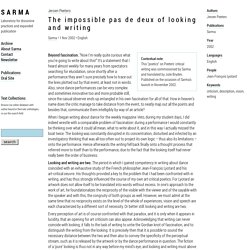
Published on the occasion of Sarma's launch in November 2002. Beyond fascination. “Now I’m really quite curious what you’re going to write about this!” It’s a statement that I heard almost weekly for many years from spectators searching for elucidation, since shortly after a performance they aren’t sure precisely how to trace out the lines plotted out by that event, at least not in words. SARMA: Dance critic: profession, role, personage, performance?
Today there appear to be no stable figures present in the field of contemporary dance.
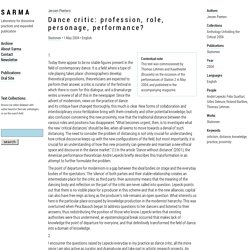
It is a field where a type of role playing takes place: choreographers develop theoretical propositions, theoreticians are expected to perform their answer, a critic is curator of the festival in which there is room for this dialogue, and a dramaturge writes a review of all of this in the newspaper. Since the advent of modernism, views on the practice of dance and its critique have changed thoroughly, this much is clear. New forms of collaboration and interdisciplinary cross-fertilization bring with them creativity and other potential knowledge, but also confusion concerning this new proximity, now that the traditional distance between the various roles and positions has disappeared.
SARMA: Performing the instantaneous, displacing criticism. Contextual note This text was commissioned by ImPulsTanz in Vienna and first published on Sarma.
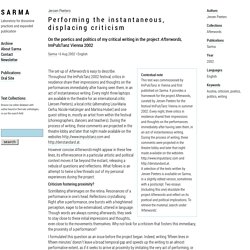
It provides a framework for the project Afterwords, curated by Jeroen Peeters for the festival ImPulsTanz Vienna in summer 2002. Every night, three critics in residence shared their impressions and thoughts on the performances immediately after having seen them, in an act of instantaneous writing. During the process of writing, these comments were projected in the theatre lobby and later that night made available on the websites and A selection of the texts written by Jeroen Peeters is available on Sarma, in a slightly edited version, sometimes with a postscript.
Two essays (including this one) elucidate the project Afterwords and reflect on its poetical and political implications. The set-up of Afterwords is easy to describe. SARMA: Dance Criticism: Negotiating Knowledge, Taste, and Power. Contextual note This text is an excerpt of a lecture Franz-Anton Cramer held on 2nd March, 2003 in Tallinn, Estonia, about his current vision of what dance criticism is all about.
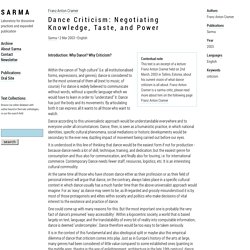
Franz-Anton Cramer is a sarma critic, please read more about him on the following page Franz Anton Cramer Introduction: Why Dance? Why Criticism? Within the canon of "high culture" (i.e. all institutionalised forms, expressions, and genres), dance is considered to be the most universal of them all (next to music, of course). Dance according to this universalistic approach would be understandable everywhere and to everyone under all circumstances. SARMA: Dance without distance. The collapse of stable figures in the field of dance making and dance writing that we have been experiencing in the past 25 years, together with an exponential emergence of different types of collaborations and cross disciplinary contaminations can only be welcomed.
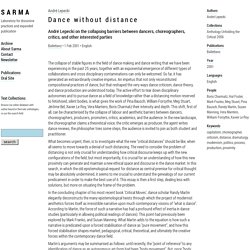
SARMA: Déplacement d’un corps critique. Avec Alain Buffard, Benoît Lachambre, Jennifer Lacey et Julie Nioche, le festival Les Antipodes, à Brest, donne rendez-vous à des projets chorégraphiques qui « ouvrent les esthétiques sans entraves ».

Et dans un passionnant ouvrage, Boris Charmatz et Isabelle Launay s’entretiennent sur « l’échafaudage » de nouvelles organisations productrices de sens. La danse est cet objet indéfini, quand bien même toutes sortes de techniques tentent d’en domestiquer la pratique, qui aurait au cœur de son projet le souci, individuel et collectif, d’émancipation. Entre dressage des corps et irruption du sujet, l’histoire même de la danse est jalonnée d’incessants allers-retours entre la police de l’asservissement et les dynamiques de la libération. Même dans sa dimension festive (plus large dénominateur commun ?) SARMA: Looking at / Writing about Dance. Contextual note Written and first published in Etcetera in Dutch, this text was translated into English by Steve Green.
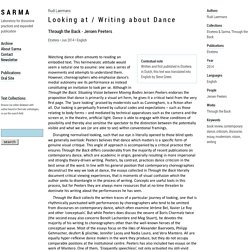
Watching dance often amounts to reading an embodied text. This hermeneutic attitude would seem a natural one to assume: one sees a series of movements and attempts to understand them. However, choreographers who emphasise dance’s medial autonomy see its performance as instead constituting an invitation to look per se. Although in Through the Back: Situating Vision between Moving Bodies Jeroen Peeters endorses the proposition that dance is primarily a visual art form, he gives it a critical twist from the very first page. Disrupting normalised looking, such that our eye is literally opened to those blind spots we generally overlook: Peeters believes that dance which matters is a specific form of genuine visual critique.
Through the Back opens and closes with linguistic imagery on visual imagery that confronts the act of looking with blind spots. SARMA: Rehabilitating Dance Criticism. Vladimir: Moron!
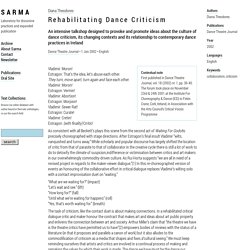
Où commence la dramaturgie ? 1 Bernard Dort, « L'état d'esprit dramaturgique », Théâtre/Public n° 67, 1986. 1En 1989, à Arles ont lieu les sixièmes assises de la traduction.
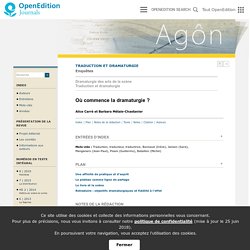
19.11 Doss Eighteen (1) Thèse Marian Del Valle. Raphael Koster, Le spectateur engagé .pdf. Performative writing. Nouvelles de danse Feedback et de mémoire à la scène. Le style des gestes Guillemtte Bolens. Cn d publication archives de spectateurs. 173818 julie perrin figures de spectateur en amateur 2017. Webdoc biblio finale. Critical Correspondence. Danses Inexpliquées 2016 Manon Santkin. : Looking without pencil in the hand. “(…) distance is often linked with the most intense state of feeling, in which the coolness or impersonality with which something is treated measures the insatiable interest that thing has for us.”
(Susan Sontag) 1. The request to talk or write about it leads time and again to the same awkwardness: the feeling of being asked to reveal someone else’s culinary secrets or recipes. 2. In artistic practice there are no fixed laws of behaviour, or task that can wholly defined in advance, not even for the dramaturge. 3. 4. 5. 6. 7. 8. 9. 10. 11. 12. “There is an immense difference between looking at something without pencil in the hand and looking at something while drawing it.”